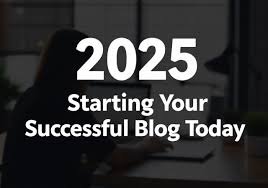Starting a blog can be an exciting and rewarding endeavor, but turning it into a successful platform that attracts and retains a loyal audience requires strategic planning, consistent effort, and a deep understanding of your readers’ needs. In 2025, the blogging landscape is more competitive than ever, making it essential to stand out with valuable content, strong engagement tactics, and smart promotion strategies. This guide provides you with step-by-step insights on how to start a blog that not only ranks on search engines but also builds a dedicated following.
1. Identify Your Niche and Define Your Purpose
The first step in creating a successful blog is selecting a niche that aligns with your passions, expertise, and audience interests. By narrowing your focus, you can create more targeted content and connect with a specific group of readers.
Key Steps:
-
Find a Profitable Niche: Use tools like Google Trends, SEMrush, and Answer the Public to explore trending topics in your area of interest. Evaluate the search volume and competition to choose a niche that has demand but isn’t oversaturated.
-
Define Your Purpose: Clearly define what you want to achieve with your blog. Whether it’s sharing knowledge, providing solutions, or offering entertainment, having a clear goal helps you stay focused and develop a consistent voice.
-
Assess Your Target Audience: Understand the demographics, interests, and pain points of your audience. This will guide the type of content you create and how you engage with your readers.
Why It’s Important:
-
Focused Content: A well-defined niche helps you craft content that resonates with your readers, increasing engagement and loyalty.
-
SEO Benefits: A specific niche allows you to optimize your content for targeted keywords, making it easier to rank on search engines.
2. Set Up Your Blog on a Reliable Platform
Once you’ve decided on your niche, it’s time to set up your blog. Choosing the right platform is crucial for long-term success. WordPress remains the best option in 2025 due to its flexibility, customization options, and SEO features.
Platform Setup Tips:
-
Choose a Reliable Hosting Provider: Opt for a reputable hosting provider like Bluehost, SiteGround, or WP Engine that offers fast load times and excellent customer support.
-
Pick a Professional Domain Name: Choose a domain name that reflects your brand, is easy to remember, and ideally contains relevant keywords. Your domain name is your online identity and should be simple, professional, and memorable.
-
Select a Mobile-Responsive Theme: Ensure your blog design is mobile-friendly, as most readers now access blogs via smartphones. Use themes from platforms like Astra or GeneratePress, which are lightweight and customizable.
-
Install Essential Plugins: Install plugins like Yoast SEO for SEO optimization, Akismet for spam protection, and WP Rocket for speed optimization.
Why It’s Important:
-
SEO and User Experience: A well-optimized blog platform ensures better performance and smoother user experiences, which are crucial for SEO.
-
Scalability: WordPress and other flexible platforms allow you to grow your blog over time, adding new features and designs as your audience expands.
3. Create High-Quality Content That Resonates with Readers
Content is the heart of your blog. In 2025, readers are more discerning than ever. To capture and maintain their attention, your content must be valuable, informative, and relevant.
Content Creation Tips:
-
Focus on Problem-Solving: Identify common problems your audience faces and create content that offers practical solutions. This type of content will be highly shareable and can attract backlinks for SEO.
-
Write for Your Audience, Not Just SEO: While SEO is important, don’t compromise content quality for keyword stuffing. Write for real people, offering insights, opinions, or entertainment they value.
-
Use Visuals: Enhance your posts with high-quality images, infographics, and videos to break up text and increase engagement. Tools like Canva and Unsplash make it easy to create and find visuals.
-
Publish Regularly: Consistency is key in blogging. Create a content calendar to plan and publish blog posts regularly, keeping your audience engaged and coming back for more.
Why It’s Important:
-
SEO Ranking: Valuable, problem-solving content is more likely to be shared and linked back to, which boosts your blog’s authority and ranking.
-
Reader Engagement: High-quality content keeps readers on your blog longer and encourages them to explore other posts, boosting engagement metrics like time on site and page views.
4. Optimize for SEO to Increase Visibility
SEO (Search Engine Optimization) is crucial for driving organic traffic to your blog. Without proper SEO, your blog won’t rank well in search engine results, making it difficult to attract new readers.
SEO Best Practices:
-
Keyword Research: Use tools like Ahrefs, SEMrush, and Google Keyword Planner to identify keywords with high search volume and low competition. Incorporate these keywords naturally into your content, titles, meta descriptions, and headings.
-
On-Page SEO: Optimize each blog post by including your primary keyword in the title, URL, and within the first 100 words. Use LSI (Latent Semantic Indexing) keywords to enhance relevancy.
-
Internal and External Links: Use internal links to direct readers to other relevant blog posts and external links to authoritative sources. This not only improves SEO but also enriches the reader’s experience.
-
Mobile Optimization: Google prioritizes mobile-friendly websites in its rankings. Ensure your blog is fully optimized for mobile devices, offering a seamless experience for users across all platforms.
Why It’s Important:
-
Higher Search Rankings: Proper SEO practices help your blog rank higher on search engines, driving more organic traffic.
-
Long-Term Growth: SEO ensures that your blog continues to attract traffic over time, even as new content is added to the web.
5. Build a Loyal Audience Through Engagement
Building a loyal audience is about creating relationships, not just delivering content. Engaging with your readers helps create a community and encourages repeat visits to your blog.
Engagement Strategies:
-
Encourage Comments: Make it easy for readers to leave comments and respond to their feedback. This encourages discussions and creates a sense of community.
-
Use Social Media to Promote Your Blog: Share your blog posts on platforms like Facebook, Instagram, Twitter, and LinkedIn to reach a wider audience. Tailor your content for each platform to drive traffic back to your blog.
-
Build an Email List: Offer incentives like free eBooks or exclusive content in exchange for email subscriptions. Use email marketing tools like Mailchimp or ConvertKit to send regular updates to your subscribers.
-
Collaborate with Other Bloggers: Partner with bloggers in your niche for guest posts, cross-promotion, or collaborative content. This helps expose your blog to new audiences.
Why It’s Important:
-
Audience Loyalty: Engaging with your readers builds trust and encourages them to become loyal followers, who are more likely to share your content and return to your blog.
-
Word-of-Mouth Marketing: A loyal audience will recommend your blog to others, providing free exposure and helping you grow organically.
6. Monetize Your Blog for Long-Term Success
Once your blog gains traction, monetization becomes a viable option. There are several ways to generate revenue from your blog without compromising its integrity.
Monetization Methods:
-
Affiliate Marketing: Promote products or services through affiliate programs like Amazon Associates or ShareASale. Earn commissions when readers purchase items through your affiliate links.
-
Sponsored Posts: Partner with brands for sponsored content, where you write about their products or services in exchange for payment.
-
Sell Digital Products: If you have expertise in your niche, create and sell digital products such as eBooks, online courses, or templates.
-
Advertising: Display ads from networks like Google AdSense or sell ad space directly to companies that want to target your audience.
Why It’s Important:
-
Revenue Generation: Monetizing your blog helps turn it into a sustainable business that can support your financial goals.
-
Diversified Income: Multiple monetization methods reduce your reliance on a single revenue stream, ensuring long-term profitability.
Conclusion: Building a Successful Blog in 2025
Starting a successful blog and building a loyal audience requires more than just posting content. It involves identifying a profitable niche, creating high-quality content, optimizing for SEO, and engaging with readers. By following the steps outlined in this guide, you can create a blog that not only attracts readers but also establishes a strong, loyal following. With consistent effort, strategic promotion, and a focus on value, your blog can thrive and grow into a long-term success.

